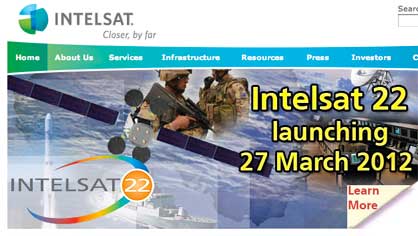Intelsat S.A. today confirmed the 2012 delivery of its Global Mobility Network, the core of which is based on five satellites launching over the next 12 months. Intelsat's mobility infrastructure will ultimately be comprised of 10 customized Ku-band mobility beams on seven satellites spread around the geostationary belt.
Through this effort, Intelsat will become the first satellite operator to offer continuous worldwide broadband coverage on a single fleet to maritime and aeronautical customers, backed by Automatic Beam Switching technology.
The launch of Intelsat 22, currently planned for late March, will kick off Intelsat's busy launch year. The satellite will be positioned at 72 degrees East over the Indian Ocean region, joining the previously launched Intelsat 14 and Intelsat 18 satellites with additional mobility beams. Over the next 12 months, Intelsat will complete its mobility fabric with the launches of Intelsat 19, Intelsat 20, Intelsat 21 and Intelsat 27.
"Our planned mobility infrastructure represents a major step forward for customers with on-the-move global communications needs," said Intelsat Senior Vice President of Global Sales Kurt Riegelman. "Maritime and aeronautical customers will benefit from robust, always-on connections at true broadband speed."
Intelsat 22 will serve media, government and network services customers in Africa, Asia, Europe and the Middle East with Ku- and C-band capacity. It also carries an Ultra High Frequency (UHF) payload that will be used by the Australian Defence Force and its allies in the region.
"Intelsat 22 is a prime example of what can be accomplished when governments think outside the box for their communications needs," said Kay Sears, president of Intelsat General Corporation. "Just three years after its contracted date, the Australians will have a critical on-orbit capability which saved them $150 million over free-flyer options, and provided them faster access to space than a traditional government procurement program."
Nairobi-based Kenya Broadcasting Corporation (KBC) has signed a multi-year agreement with Intelsat to distribute broadcast programming from production facilities to terrestrial base stations around the country to service its newly launched DTT network. The signals will then be transmitted over the terrestrial airwaves to homes around Kenya. KBC will use capacity on the Intelsat 709 satellite and transition to the new Intelsat 22 satellite once it enters service.
KBC will join Addis Ababa-based ETHIO Telecom, which signed a multi-year, multi-transponder deal for new capacity on Intelsat 709, with follow-on service on Intelsat 22. As previously announced, ETHIO Telecom plans to use the capacity for a new government voice and data network, and for the expansion of a distance learning network that supports high school education in Ethiopia.
Intelsat 22 will also be used by Etisalat UAE, a leading telecommunications services provider in the Middle East, which signed a multi-year, multi-transponder agreement for capacity on Intelsat 22. As previously announced, Etisalat will use Intelsat 22 to expand its broadband and GSM backhaul services in the Middle East, Africa, Europe and central Asia.
For more information, visit the Intelsat booth (#409) at Satellite 2012 in Washington, D.C., March 12-15.



